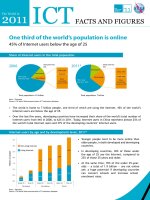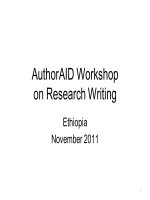UK facts and figures
Bạn đang xem bản rút gọn của tài liệu. Xem và tải ngay bản đầy đủ của tài liệu tại đây (58 KB, 11 trang )
Test your knowledge with this general knowledge quiz.
UK facts and figures
11
1. True or false: The UK is a union of four countries: England, Scotland, Wales and Ireland.
2. Rearrange the letters in bold to make words:
The full name of the UK is the nitdUe nodimgK of retGa tariBin and erotNnhr redl
I
na.
3. True or false: Great Britain is another name for the UK.
4. Is there just one government for the whole of the UK?
5. Who is the Head of State of the UK?
6. Where might you expect to hear Welsh being spoken? Where might you expect to hear Gaelic being
spoken?
7. Would you be making a mistake if you called someone from Scotland, Wales or Northern Ireland
'English'?
8. What are the principal (capital) cities of Scotland, Wales and Northern Ireland?
9. What is the population of the UK (based on the 2001 census)?
(a) About 25 million (b) About 36 million (c) About 49 million (d) About 59 million (e) About
72 million
10. True or false: There are more people in the UK aged 60 or over than there are aged 16 or under.
11. Match the ethnic groups on the left with their relevant population percentage figures on the right:
12. What is the largest ethnic minority in the UK?
13. Where would you find the single biggest concentration (45%) of ethnic minorities in the UK?
14. What percentage of people in the UK say that they have a religion?
(a) 98% (b) 86% (c) 75% (d) 62% (e) 50% (f) 42% (g) 30%
15. Rearrange the letters in bold to make the names of the most common religious faiths in the UK:
hudBimsd hmikSis imnuHids sm
I
al nthritiCiyas imaudJs
16. What percentage of people in the UK who have a religion say that they are Christians?
17. What percentage of the people in number 16 above say that they go to church regularly?
18. In which year did the Church of England come into existence?
(a) 1066 (b) 1215 (c) 1485 (d) 1534 (e) 1642 (f) 1707
19. What and who is the Supreme Governor?
20. Identify the word in the following group that does not belong with the others, and explain why:
Anglican Baptist Quaker Methodist Catholic Presbyterian
21. How far is it (in miles) from the north coast of Scotland to the south coast of England?
22. How far is it (in miles) across the widest part of the United Kingdom, from the west coast of Wales
to the east coast of England?
23. In which UK cities might you expect to hear the following dialects and accents?:
(a) Geordie (b) Brummie (c) Scouse (d) Cockney (e) Glaswegian
White
Mixed
Asian or Asian British
Black or Black British
Chinese
Other
0.4%
2%
92%
0.4%
4%
1.2%
24. Below is a list of the fifteen largest cities in the UK (in terms of population). The first part of each
city is in the left-hand box, and the second part is in the right-hand box. Match the two parts of
each city together.
25. What is the minimum age for voting in a UK election?
26. Which of the following are not recognised UK political parties?
27. What sector of industry accounts for the largest proportion of GDP (gross domestic product) in the
UK?
28. Approximately what percentage of the UK's able-bodied population of working age is unemployed?
(a) 5% (b) 8% (c) 12% (d) 15% (e) 20% (f) 24%
29. Do young people in the UK have to do compulsory military service?
30. Can women join the armed forces?
31. Approximately what percentage of women with children of school age are in paid work?
(a) 25% (b) 35% (c) 45% (d) 55% (e) 65% (f) 75% (g) 85%
32. Can a company or business legally pay women less than it pays men for doing the same job, or can
it legally refuse to employ them because of their sex?
33. Are drugs such as cocaine, heroin, marijuana and ecstasy legal in the UK?
34. Does the UK have capital and / or corporal punishment?
35. What proportion of young people go on to higher education after they have finished school?
(a) 1 in 3 (b) 1 in 5 (c) 1 in 10 (d) 1 in 15 (e) 1 in 20
36. How old do you need to be in the UK to:
(a) Buy and smoke cigarettes?
(b) Buy and drink alcohol?
(c) Drive a car?
(d) Get married with your parents' permission?
(e) Get married without your parents' permission ?
(f) Join the armed forces?
(g) Have sexual relations with a member of the same or opposite sex?
12
The Red Lion The Scottish National Party (the SNP) Sinn Fein
The Conservative Party The Green Party The Rose and Crown
The British National Party (the BNP) The Liberal-Democrats Plaid Cymru
The Ulster Unionist Party The Social Democratic and Labour Party (the SDLP)
The White Hart The Labour Party
Lon… Birmi… Le…
Glas… Shef… Brad…
Edin… Liver… Manch…
Bris… Card… Cove…
Leice… Bel… Notti…
…ntry …ester …iff
…field …fast …burgh
…ngham …ster …ford
…gow …pool
…ngham …tol …don
…eds
Exercise 1
: UK food has a bad reputation abroad, even with people who have never eaten
it (the President of a European country famously said that we have the world's second
worst food after Finland!). However, this reputation is not really justified, as there are many
delicious national and regional dishes that are worth trying.
Match the names of some popular dishes 1 – 26 in the first box with their description A –
Z in the second box.
Food
13
(1) bangers and mash (2) black pudding (3) bubble and squeak (4) butty or sarnie
(5) Cheddar, Cheshire, Wensleydale, Lancashire and Red Leicester (6) Christmas dinner
(7) Cornish pasty (8) cream tea (9) fish and chips (10) full English
(11) haggis (12) hot cross bun (13) Irish stew (14) Lancashire hotpot
(15) mince pies (16) ploughman's lunch (17) sausage roll (18) shepherd's pie
(19) steak and kidney pie (20) Sunday roast (21) tatties and neeps (22) tikka masala
(23) toad-in-the-hole (24) trifle (25) Welsh rabbit (26) Yorkshire pudding
A. Sausages baked in a mixture of eggs, flour and milk.
B. A breakfast of cereal and fruit juice, followed by bacon, eggs, sausages and mushrooms, and
finished with toast and jam or marmalade. Accompanied with tea or coffee.
C. A traditional family lunchtime meal of meat and potatoes cooked in an oven, and served with
vegetables and gravy.
D. Sausages and mashed potato, traditionally served with onion gravy.
E. A traditional Scottish food, made from the inner organs of a sheep that are cut into small pieces,
mixed with grain and pushed into the skin of a sheep's stomach before being cooked.
F. A Scottish mixture of potatoes and turnips, often eaten with haggis.
G. Pastry filled with fruit and spices and then baked, usually eaten at Christmas.
H. A small meal eaten in the afternoon, consisting of tea with scones (a sweetened bread-like food),
jam and thick cream.
I. A thick soup made from lamb, potatoes, onions and other root vegetables.
J. A thick soup made from meat (usually lamb) and vegetables, topped with sliced potato and cooked
in an oven until the potatoes go crispy.
K. A thick sausage made from pig's meat and blood, traditionally sliced and fried, and eaten for
breakfast.
L. A sweet food made from cake, covered with fruit, jelly, custard and sometimes cream.
M. A traditional family lunchtime meal of roast meat (usually turkey), roast potatoes and parsnips,
served with vegetables and gravy, and followed by a steamed fruit-based pudding.
N. Flour, milk and eggs mixed together, baked in an oven and usually served with roast beef.
O. The most famous British takeaway food! Battered, deep-fried seafood (usually cod) served with
deep-fried potato strips. Typically eaten straight out of the bag it is wrapped in.
P. Cooked potatoes and other vegetables (especially cabbage), which are mixed together and then
fried. A popular way of using up leftover vegetables.
Q. Informal words for a sandwich.
R. Minced lamb in a thick gravy, covered with mashed potato and baked in an oven.
S. A simple meal of bread, cheese (or sometimes cold meat), pickles and salad (often served with an
apple).
T. Meat (beef) in a thick gravy, topped with pastry and baked in an oven.
U. A small tube of pastry with pork sausage meat inside, baked in an oven.
V. A small pie for one person, with meat, potatoes and other vegetables inside.
Exercise 2: People from the UK travel abroad a lot for their holidays, and as a result have
developed a taste for foreign food. This, coupled with an influx of immigrants to the UK in
the 50's and 60's, has resulted in a huge range of foreign foods becoming available and
popular throughout the country.
Look at the different food groups and dishes / ingredients below (these are the most
popular ones that you will find in the UK), and identify the one word or expression in each
group that does not belong with the others (because it does not originate in that country
or area).
14
W. Popular types of British cheese.
X. Toast, covered with a cheese-based sauce and cooked under a grill.
Y. A sweet cake for one person, containing dried fruit and spices, traditionally eaten at Easter.
Z. A meat dish combining British and Indian ingredients (cream, yoghurt, spices, etc), developed by
Indian chefs for British tastes.
1. Italian
:
focaccia, tortellini, polenta, couscous, minestrone, spaghetti, cannelloni, carpaccio.
2. Indian & South Asian
:
naan, chapati, dhal, jalfrezi, dopiaza, passanda, vindaloo, tagine, balti.
3. Chinese
:
chow mein, spring roll, chop suey, goulash, prawn wanton, egg fried rice, spare ribs, dim sum.
4. Lebanese & Middle-Eastern
:
kebab, falafel, jerk chicken, houmous, tabbouleh, kibbeh, baba ganouje, khubz bread.
5. Japanese
:
saganaki, sashimi, teriyaki, yakitori, tempura, sukiyaki, miso, wasabi.
6. French
:
chicken chasseur, cassoulet, boeuf bourgignon, salad niçoise, bratwurst, escargots, tapénade,
soufflé.
7. Spanish
:
tapas, tortilla de patata, paella, caviar, gazpacho, chorizo, jamon Serrano, emparedados.
8. Mexican
:
mole, tamales, fajitas, quesadillas, burritos, tacos, kimchi, enchiladas.
9. Greek
:
pitta, stifado, blini, kleftiko, tzatziki, baklava, taramasalata, horiatiki
10. South-East Asian
:
chicken satay, piri-piri chicken, nasi goreng, beef rendang, mee goreng, laksa, gado-gado, otak
otak.
Exercise 1
: Complete sentences 1 – 18 with a word(s) or number from the box. There are
some words / numbers that do not fit in any of the sentences.
Healthcare
15
¼
100
¼
112
¼
999
¼
118118
¼
ambulance
¼
A and E
¼
ASBO
¼
conscription
¼
cure
¼
dispensary
¼
fitness centre
¼
GP
¼
health authority
¼
health check
¼
health club
¼
HP
¼
MA
¼
medical card
¼
mental
¼
NHS
¼
NHS Direct
¼
patient
ț
paramedics
ț
pharmacist
ț
prescription
ț
register
ț
specialist
ț
surgery
ț
treatment
1. The __________, set up in 1948, is a system that provides free medical care and is paid for through
taxes.
2. A family doctor is also known as a __________.
3. A family doctor will normally work in a health care centre, sometimes also known as a _________.
4. Family doctors are responsible for providing most of the _________ for any illnesses that you may
have.
5. This includes __________ as well as physical illness.
6. If they are unable to __________ you, they will usually refer you to a __________.
7. Before you see a doctor for the first time, you will need to __________ with your local health care
centre.
8. In order to do this, you will need a __________.
9. These are available from your local __________ (you can find the telephone number in the phone
book, or from your local library).
10. Unlike many other countries, there are a lot of medicines that you cannot buy 'over the counter' in a
shop: you might need to get a __________ from your doctor.
11. You either take this to the __________ in the health care centre, or to the nearest chemist, where a
trained __________ will prepare the medicine for you.
12. In an emergency (for example, an injury), you should go to the __________ department in your
nearest hospital.
13. If you are unable to get there yourself, and if no one else can take you, you should call for an
__________.
14. The number you need to call for one of these is __________ (or alternatively you can call
__________). Remember, however, that these numbers are for genuine emergencies only.
15. The people who drive these are called __________, and they can often provide a range of
emergency treatments (or take you to the hospital if they are unable to treat you on the spot).
16. A person receiving medical treatment is called the __________.
17. When you register with a doctor for the first time, you are entitled to a free __________.
18. __________ is a free 24-hour health information service which can give advice on various health
issues. If you need advice, or are feeling ill, you can call them on 0845 4647.









